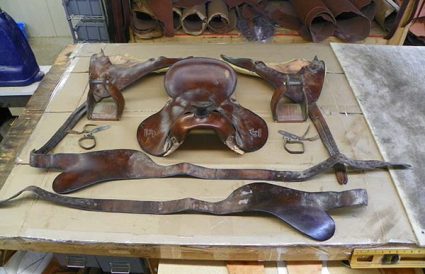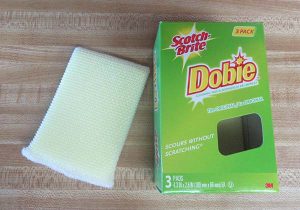Last week we had a saddle come into the shop that my dad built over 25 years ago. The billets needed to be replaced because they where dry and cracking, an obvious safety issue. Also, in the customer's own words "please make it beautiful again!"
After looking over the saddle I recommended that we recondition the saddle as well as replace the old strings and hardware. The customer also decided to add some Jeremiah Watt Accented Silver Conchos to complete the makeover.
Here is the saddle I received:
A leather saddle needs periodic maintenance. It needs to be cleaned once in a while as well as oiled and conditioned to keep the leather soft and supple. The success of reconditioning an older saddle is dependent on what shape the leather is in.
The leather on this saddle was dirty and a bit grimy but didn't have any deep cracking yet. So I got to work on it. The first thing I did was strip the saddle down so I could work on all the individual pieces.
There are a lot of leather cleaning products for you to choose from. On a saddle that is really dirty I like to mix 2 ounces of Murphy's Oil Soap (yes, this is intended for cleaning wood surfaces) with a half a gallon of hot water. Murphy's uses a vegetable oil that is a perfect match for vegetable tanned leather. I use a Dobie sponge because it can scour without scratching the leather. Once all of the dirt and grime have been removed I put the pieces aside to dry.
Next I made a set of billets to replace the old cracked ones. I cut the stitches on the back side of the skirts and then removed the old billets. Then I glued the new billets in the skirts and stitched them in using the original stitch holes.
After finishing with the billet replacement I applied a light coat of dye to even out the discolored leather and then oiled everything with 100% Pure Neatsfoot Oil. After the oil soaked in, I conditioned the leather with a coat of Bickmore Bick-4 Leather Conditioner.
As a final step I reassembled the saddle and replaced the strings and hardware as well as installed the new silver conchos.
Ideally you should perform periodic maintenance of your saddle. If you ride daily you should take a damp cloth and wipe the sweat off any leather that touches the horse. A more thorough cleaning should be done every 6 to 8 weeks in an area with average humidity. More often if you live in a dry climate.
If you only ride a couple times a week, you might only need to clean your saddle 2 or 3 times a year. Remember that any time you clean your saddle to put a light coat of oil to keep the leather from drying out. You can also use Bick-4 conditioner in between major cleanings to keep your saddle looking nice.











Comments 7
Thanks for the thorough description re saddle conditioning.
Beautiful job!
What kind of saddle is the one you reconditioned.
Author
Hi Karlie,
this saddle is a 25 year old trail saddle that my dad built back in the 90s.
Dave
Author
It’s a lightweight trail saddle.
Dave
I just received 2 of my late aunt’s saddles. They were left in her trailer with no heat many years. What is the best way to clean them, as I just want to have them for decoration & memory of her. The western saddle has yellowing wool. Is that able to be cleaned? Thanks!
Author
Hi Autumn,
This article pretty much describes how I go about cleaning an old saddle. As far as the sheepskin on the bottom of the skirting, when it gets too old it is a general practice to just replace it.
Dave